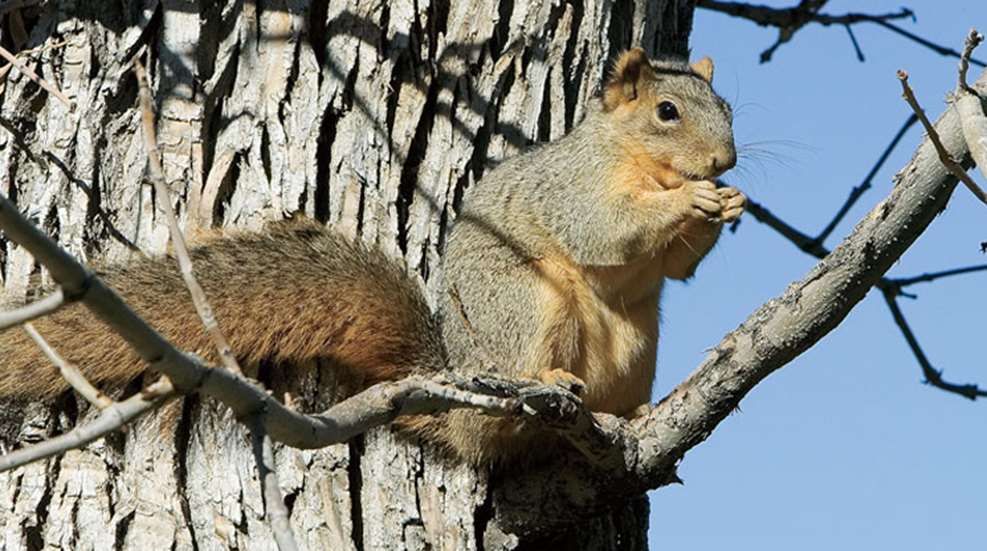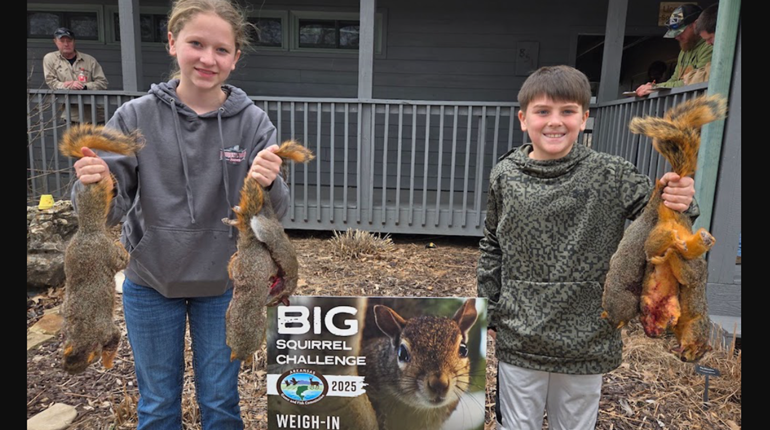
Remember those crazy days of October and November when seemingly every whitetail in the woods was on the move? The brilliant leaves, frosty mornings and jacket-weather evenings provided the perfect backdrop, too. But Robert Frost said “nothing gold can stay,” and he was right. Your deer tags are filled. Your bow is cased and your favorite centerfire is in the safe. It’s cold and gray and silent outside.
But your business in the woods is far from over. Those squirrels that aggravated the living hell out of you while you sat in your stand each day are still out there. Not too many years ago, squirrels were the game to hunt in the fall. Sure, there weren’t many other options in some areas, but with today’s deer hunting craze, many have forgotten that squirrels are still a ball to hunt and great to eat.
And when was the last time you took a shot at a rabbit? If you’re like me, it’s been a while. I have quite a few hunting buddies, but only two with pens full of beagle hounds. They invite me to join them every year but it seems I only accept the invitation every three years or so. I’m not sure why I don’t go more often because I’m always craving one more chase by the day’s end.
The fact is, when you throw squirrels and rabbits into the mix, there are a lot more things to do this time of year than many give credit. Rabbits and squirrels are accessible, inexpensive types of hunting that appeal to a variety of tastes. You’re going to have fun if you’re a shotgunner, but some of the most obsessive squirrel hunters I know are rifle accuracy fanatics. And anyone who appreciates good dog work is bound to enjoy a pack of beagles.
We want you to rethink your small-game opportunities this winter—here are a few ideas to get you started.
SQUIRRELS
There are a few key considerations for late-season squirrel hunting. First, the leaves will be gone, and acorns, hickory nuts and other hard mast will be on the ground, rather than in the trees. This is where the squirrels will spend most of their time, too.
Sit Quietly, and Carry a Little Gun
My friend Ricky King hunts 50 to 60 days each squirrel season. Fried squirrel is one of his favorite meals and he’s rarely lacking in the main ingredient. But King is in a unique situation compared to most squirrel hunters—he can’t walk due to an ATV accident he suffered more than 25 years ago.
“I grew up hunting and fishing, and when I was in the hospital after my accident, I made up my mind that my injury wasn’t going to stop me from continuing to enjoy my favorite sports,” King says. “But, of course, I had to change my methods a little bit. I learned over the years that I would be limited in mobility, so to be effective, whether deer hunting or squirrel hunting, I’d better become a good long-range shot.”
These days, ironically, King hunts from an ATV. He parks it in a likely, hidden area, and he waits. His gun is a bull-barreled CZ .17 Mach2, topped with a 6.5-20x40 Leupold. “I can sight that rifle in at 50 yards and hit a squirrel in the head at 100,” King says. “I’ve killed thousands of squirrels in my lifetime with a .22, but even the best .22 rifle isn’t in the same class as that .17.”
King says even if he wasn’t confined to one spot, his handicap has taught him a great deal about late-season squirrel hunting. “I often find myself thinking back to when I didn’t have the patience to sit still for long, and I’d get up and start trying to sneak around the woods on foot—often, the leaves were dry and noisy, and I wouldn’t get many squirrels. I shoot a bunch more now that I’m sticking to one likely spot—and it’s made me realize that patience can really pay off.”
Spot and Stalk on Rainy Days
Sticking to one spot with an accurate rimfire is an especially productive strategy in the winter, but hitting the woods after a good rain can create one of the best spot-and-stalk situations of the year, since virtually all squirrel movement will be on the ground. Closely watch a ground-foraging squirrel next time you’re in the woods; often, they’ll jump onto the base of a tree trunk to survey their surroundings before moving on.
When the leaves are wet, you can exploit this habit to quickly and silently sneak up on a squirrel. Keep an eye on a distant squirrel searching the ground for acorns, and carefully slip to within 50 or 60 yards of it. This is usually pretty easy when the critters are preoccupied and the leaves are wet. When the squirrel jumps onto a tree trunk, quickly work your way around it, so that the trunk blocks you from the squirrel’s view—then head straight toward the squirrel at a near jog. Stop within 10 seconds and be ready to shoot as soon as you see the squirrel’s head. This technique is comically simply and amazingly effective. It’s my favorite way to hunt with a rimfire handgun or my bow, as the shot distance is often measured in feet, rather than yards.
Hunt Fox Squirrels at Midday
Although early morning and late in the evening are by far the best times to be in the squirrel woods during the early days of season, the same isn’t true once winter takes hold. In fact, when the temperature falls much below freezing, your best chance at a good squirrel hunt may be after you’ve slept in. Fox squirrels, especially, seem to move well into the late-morning hours. Focus your efforts on small woodlots that have plenty of hard mast trees, particularly if those woodlots border a cornfield. The big squirrels prefer such broken habitat, in contrast to deep-woods loving gray squirrels, and they’re especially prone to snatching ears of corn from a farmer’s field. Fox squirrels also typically stay in one tree and try to hide when danger approaches, rather than attempt to scurry away at high speed—this is a character trait that you can exploit when the leaves are gone, especially if you use the next tip in the list.
Bring a Buddy
Squirrel hunters who use dogs love the late-season because the leaves are gone from the trees; in fact, it can be virtually impossible to get a shot at a “treed” bushytail when the foliage is still thick early in the year. But most squirrel doggers have also learned to bring a buddy along for the hunt so that they can circle around a tree and spook a hiding squirrel into revealing itself for a shot. This is a good tip for all late-season squirrel hunters—with or without dogs, and whether hunting from a stationary position or spot-and-stalking. A spooked squirrel attempting to hide in a tree can be a tough target if you’re alone. Each time you circle the tree for a better shot, you can bet the squirrel will be watching and circling his limb accordingly. Tossing a rock or stick to the other side of the tree in hopes of spooking the squirrel around to you will sometimes work, but most squirrels figure this ploy out rather quickly. But if you have a buddy along, he can circle the tree. One of you is virtually guaranteed an easy shot.
RABBITS
My buddy and former college roommate Ryan McCafferty has been rabbit hunting for more than 20 years. In fact, as of press time, his first rabbit dog, Dixie, is still kicking at age 19—though she’s nearly deaf and blind. McCafferty says of all things for a late-season rabbit hunter to consider, thick cover is the most important.
Find the Dozer Piles
Fencerows and other obvious cover have been picked over by this time of year. If it’s easy walking for a hunter, or a coyote can sneak through it or a hawk can see into it, chances are there aren’t any rabbits left in it.
McCafferty says, “Here in western Kentucky, where I hunt, and other areas I’m sure, many farmers have cleaned out their fencerows over the years, and they often have an acre-sized dozer pile of brush sitting in their field as a result. These are ideal for late-season cover. If a dog has trouble getting through it, you can bet there are some rabbits in it. In fact, there have been several times when I’ve seen four or five rabbits hiding under a single big dozer pile.”
Let the Dogs Work
Covering ground often means jumping more rabbits in the early season, but it can be counter-productive late in the year. “Because the best cover, like those dozer piles, can be so thick and isolated, it’s important to let the dogs work it thoroughly,” McCafferty says. “I often jump rabbits myself early in the season when walking ditches and fencerows, but I seldom jump any like that late in the year. If my dogs are really working a brush pile and showing no interest in moving on, it’s probably because they smell something. So settle in, be patient and let them work. Rabbits have learned by this time of year that if they sit tight in heavy cover, they’re the safest. But they’ll move if a dog gets right on top of them.”
Pick the Best Days
McCafferty’s best rabbit-hunting days in the late-season are usually bright, clear and warming up following a cold night—especially if there’s a little snow on the ground. “The dogs always seem to be able to pick up scent easier if there’s some moisture on the ground,” he says. “It’s difficult for them to smell anything when the ground is frozen. Plus, I think rabbits are a lot like people—they want to be out moving and feeding when the weather is more pleasant.”
Load up with 4s
Physically, rabbits are fragile, so many hunters use smaller shot. But increasing your pellet size to No. 4s can be beneficial, especially when shooting in thick cover late in the year. One advantage is that you’ll have fewer tiny pellets to pick out of your fried rabbit quarters. But the larger pellets also have more energy for longer shots and for breaking through brush. A hit from a single No. 4 pellet, regardless of where it strikes, will usually stop a moving rabbit.
Take a Stand
Once your dogs strike a cottontail and the chase begins, just stand still. “I believe rabbits are really only familiar with the general area of where you jump them most of the time,” McCafferty says. “They rarely run as far as you think during a chase—and they’ll virtually always return. So, provided your dogs don’t run deer, stay put and just listen to them. Even when the dogs sound distant, be patient and stay ready. Some hunters make the mistake of believing the dogs are always right on a rabbit’s heals during a chase, so a distant bark can be misleading. But, often, the rabbit is 100 yards or more ahead of them and taking its time.”







































